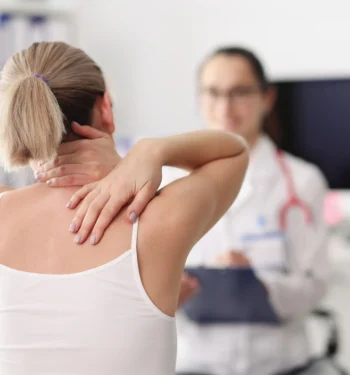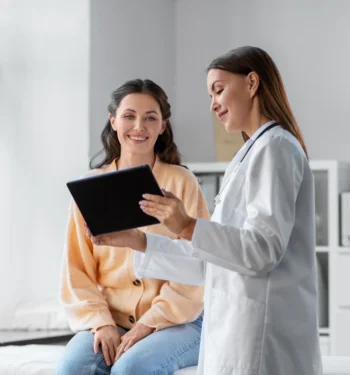
What Causes a Lumbar L5-S1 Disc Herniation, and What Are the Symptoms?
The lumbar spine provides strength, stability, and flexibility to the lower back, supporting everyday movements such as bending, twisting, and lifting. At the base of the spine, the L5-S1 disc plays a critical role by acting as a cushion between the last lumbar vertebra and the sacrum, absorbing shock and helping to distribute the body’s weight. Because of this heavy workload, the L5-S1 disc is particularly vulnerable to wear and injury. When the outer layer of the disc weakens or tears, the soft inner material may push outward, resulting in an L5-S1 disc herniation.
There are many common causes of disc herniation. Natural disc degeneration occurs gradually with age, reducing the disc’s ability to absorb impact. Sudden injuries from twisting or falling, repetitive heavy lifting, and years of poor posture can also place excess strain on the lower spine. In addition, certain risk factors — including family history, smoking, being overweight, or working in physically demanding jobs — can increase the likelihood of developing a disc problem at the L5-S1 level.
The symptoms of an L5-S1 disc herniation can vary in intensity. Many patients report persistent lower back pain that worsens with activity. Pain may also radiate down one leg, a condition commonly referred to as sciatica, when the herniated disc presses against the sciatic nerve. Other frequent symptoms include tingling, numbness, or muscle weakness in the legs or feet, which may make it difficult to walk, stand for long periods, or complete everyday tasks. If nerve root compression is significant, patients may find their mobility and overall quality of life affected.
For those seeking expert care, advanced herniated disc treatment in Indiana is available through the specialists at Goodman Campbell, where a dedicated team focuses on long-term recovery and spinal health. Their physicians use advanced imaging tools to pinpoint the problem, evidence-based therapies to relieve pain, and a compassionate approach to guide patients through every step of care. With Goodman Campbell’s expertise, patients not only find relief from discomfort but also receive the education, encouragement, and support needed to regain independence and return to active living with confidence.
How Is an L5-S1 Disc Herniation Diagnosed by Doctors?
Accurate diagnosis of an L5-S1 disc bulge begins with a thorough review of your medical history and a detailed discussion of your symptoms. Doctors will want to know when your pain started, what activities worsen or relieve it, and whether you’ve experienced related concerns such as numbness, weakness, or difficulty walking. This initial conversation provides important clues about the potential severity of your condition and helps guide the next steps in evaluation.
A physical exam is often the next stage. During this assessment, your physician may check muscle strength, reflexes, flexibility, and sensation in the lower back and legs. For instance, simple movements like walking on your heels or toes, or raising one leg at a time, can help identify areas affected by nerve irritation. These clinical signs often point to whether nerve root compression is present and how much it is impacting daily function.
Advanced imaging techniques are used to confirm the diagnosis. MRI scans are considered the gold standard, as they can clearly show the disc itself, the surrounding nerves, and the degree of herniation. CT scans may also be used in certain cases to provide additional detail or when an MRI is not an option. These imaging results allow doctors to see the precise location and extent of the disc bulge, ensuring that treatment recommendations are based on accurate information rather than assumptions.
Because every patient’s condition is unique, it is essential to consult with experienced specialists, including interventional pain management physicians and spine experts. These providers have the expertise to not only interpret imaging results but also to tailor a treatment plan that reflects your lifestyle, health goals, and preferences. They know when to recommend conservative care, such as physical therapy or medications, and when it may be appropriate to escalate to more advanced procedures.
At Goodman Campbell, patients benefit from a truly personalized approach. Our skilled care teams combine advanced diagnostic tools with years of specialized experience to ensure each patient is carefully evaluated. This comprehensive process helps avoid unnecessary treatments and allows patients to move forward with confidence, knowing their care plan is designed to achieve the best possible outcome. By working closely with patients at every stage, Goodman Campbell provides clarity, reassurance, and expert guidance on the path toward recovery.
What Are the Most Effective Treatment Options for Lumbar L5-S1 Disc Herniation?
The type of L5-S1 disc bulge treatment a patient receives depends on both the severity of their symptoms and their individual health needs. Many patients find relief through L5-S1 disc bulge treatment without surgery, which may include L5-S1 disc bulge physiotherapy treatment, posture correction, and targeted exercise programs. Therapists will often also provide advice on specific exercises to avoid that could worsen pain or slow recovery, including heavy weightlifting, deep squats, and high-impact activities such as running or jumping.
Doctors may prescribe medication for herniated disc pain as part of a comprehensive plan. Some patients benefit from epidural steroid injections and other therapies overseen by interventional pain management physicians.
For more severe cases, surgical options such as lumbar decompression and fusion, laminectomy, or minimally invasive procedures may be recommended. Goodman Campbell specializes in these types of innovative approaches, all of which are designed to minimize recovery time and preserve spinal function, while also providing comprehensive patient support from interventional pain management specialists throughout treatment.
Importantly, it should be noted that L5-S1 disc degeneration treatment is never one-size-fits-all; many patients achieve relief through nonsurgical methods, while others find surgery the most effective solution. The goal is always to ensure the best possible outcome for each individual.
How Long Does Recovery Take for Patients With an L5-S1 Disc Herniation?
L5-S1 disc bulge recovery time varies depending on treatment choice and personal healing. Nonsurgical recovery may take several weeks to a few months with structured physical therapy, lifestyle modifications, and a gradual return to daily routines. Patients who undergo surgery may need a longer healing period but can often return to normal activities within several months, especially when they commit to rehabilitation exercises and follow-up care.
Your recovery outlook improves greatly when you follow medical advice, stay consistent with prescribed therapies, and actively participate in your rehabilitation plan. Returning to activity — whether work, exercise, or household responsibilities — should always be guided by your healthcare team to prevent setbacks and support steady healing.
Many inspiring patient stories at Goodman Campbell highlight how, with dedication, expert medical support, and comprehensive follow-up, people successfully regain independence and return to fulfilling lives after an L5-S1 disc herniation.
Living Well After L5-S1 Disc Herniation: Tips and Keys for Long-Term Back Health
Recovery doesn’t end once symptoms improve; protecting your spine requires long-term attention to back health and injury prevention.
Patients are advised to avoid certain movements, with guidance on L5-S1 exercises to avoid in order to reduce strain and prevent reinjury. A sustainable routine of stretching, strengthening, and low-impact aerobic activity — developed in collaboration with a physical therapist — can also support ongoing wellness and improve overall flexibility.
Maintaining regular check-ins with your care team is also essential to ensure long-term success. These visits provide opportunities to adjust exercise plans, evaluate posture, and address new concerns before they become more serious. By combining healthy posture habits, core stability, and personalized activity planning, patients can enjoy lasting wellness, improved mobility, and confidence in their recovery journey.
Understanding Lumbar L5-S1 Disc Herniation (and the Journey to Recovery)
Every story of overcoming back pain is a reminder that resilience and healing are possible. The L5-S1 disc plays a vital role in spinal stability, and damage to it can feel overwhelming, limiting not only movement but also confidence in daily life. Symptoms can disrupt work, family activities, and even simple routines, leaving patients feeling uncertain about the future. Yet, with the right care, consistent treatment, and determination, it is possible to move from pain and frustration to renewed strength, independence, and hope.
At Goodman Campbell, patients are never alone on this journey. The team is deeply committed to providing not only advanced medical care but also compassion, encouragement, and education. With access to state-of-the-art diagnostics, innovative treatments, and ongoing support, patients are guided through every stage of recovery with confidence. Whether you’re facing an L5-S1 disc herniation or an L5-S1 disc bulge, Goodman Campbell’s specialists work side by side with you to reduce pain, restore function, and build a path toward long-term wellness. Our goal is not only to relieve symptoms but also to help you return to the activities and lifestyle that bring fulfillment.
Take the Next Step — Ask Your Doctor About Goodman Campbell
At Goodman Campbell, patient-centered care is built on expertise, communication, and compassion. Through personalized guidance, patients find encouragement and strength during each stage of treatment and recovery.
If you or a loved one is struggling with disc-related pain, don’t face it alone. Explore our patient stories, all of which prove that healing is possible, and take heart in knowing that hope is always within reach.
Request an appointment or ask your doctor about Goodman Campbell today and take the next step toward long-term spinal health and happiness.


